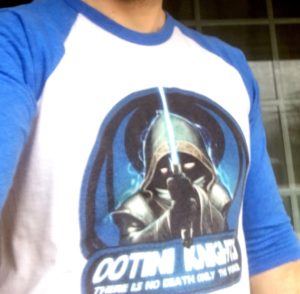Podcast: Play in new window | Download
Subscribe: RSS
We cover some news, and then go over what Charles Boyd revealed in BioWare’s first Facebook livecast. We then discuss gaming as a way of dealing with depression and anxiety.
1. Introduction
2. Tip of the week
Congratulations to this week’s winner, Ammiziva! Thanks to Nautic for entering.
Please send your tips to ootinicast@gmail.com by next Wednesday for a chance to win a Taunfawn or M8-3R droid code, courtesy of BioWare, and an OotiniCast-provided Cartel Market pack from the latest shipment.
3. Holofeed
- In Game Update 5.1.2 coming on 28 February, the White Acute Module will be purchaseable for subscribers and non-subscribers. It will allow the 2.5x bonus to leveling XP (pre-70) that is currently in place to be disabled.
- After Game Update 5.2, while the CXP bonus event will be over, the rate at which players gain CXP will be higher than it was prior to the event starting in Game Update 5.1.1.
- If you encounter an error saying “This application has encountered an unspecified error. Please try this patch again.”, restart the launcher or delete the BitRaider folder.
- It seems there are bots or players using cheats rife on Zakuul, farming all the mats! Eric reminds us what to do if we encounter characters exhibiting suspicious behaviour.
- BioWare have tried their first Facebook livecast with “SWTOR Live: The Evolving Story” (also available on YouTube), with Eric Musco posing questions about the SWTOR story to Charles Boyd.
- An article claims that a tweet (subsequently deleted) from Pablo Hidalogo of the Star Wars story group indicates that there will never be an Old Republic movie, as being asked for in this petition.
- The novel Thrawn tells the backstory of Grand Admiral Thrawn, who was recently returned to canon in Star Wars Rebels.
4. The Academy
Swtorista tells us all about Galactic command: how it works, and how to get endgame gear at level 70!
5. Force Feedback
Blachloch (Blay) wore his Ootini Rage shirt when he joined us for Episode 300, saying “There can only be one t-shirt tonight”:
To which Ironweakness responded “There is another…”:
The following picture is from the YouTube recording of Episode 116, in which Teo experienced a temporary (?) madness and donned a cap. Backwards.
The article by Greg Street (Ghostcrawler) that was sent to us by Count Looku can be found here.
6. Sarlacc Digest
Our guest LiebeAroha discusses experiencing both depression and anxiety, and how gaming can provide a most helpful escape and even treatment for her illnesses. She provided the following information about her condition:
Depression research
- Depression/depressed often used colloquially to a moment in time or a more temporary reaction
- Classified through the Diagnostic and Statistical Manual of Mental Disorders (DSM-5) and the International Classification of Diseases (ICD-10)
- Major Depressive Disorder (MDD)
- Dysthymic Disorder (DD)
- Bipolar Disorder (BD)
- Each diagnosis is defined by a set of inclusion/exclusion criteria that identify the presence of a particular condition
- There is no good evidence that each threshold separates the different diagnoses into distinct user groups
Major Depressive Disorder
- “Presence of at least one discrete and distressing/impairing period of depression, formally referred to as a major depressive episode (MDE)”
- Must experience at least five symptoms of depression that are a change from the individual’s prior state and functioning
- This MUST include a disturbance of mood – depressed mood or anhedonia. Depressed mood must be observable by others and must be present most of the day nearly every day, and anhedonia is a near complete loss or serious decrease in feelings of pleasure derived from one’s activities
- Changes to circadian rhythms also present
Dysthymic disorder
- Chronic mood disorder
- Mood may be noticeable to others
- For diagnosis, two of the following must be present:
- Appetite problems (overeating or poor appetite)
- Sleep difficulties (insomnia or hypersomnia)
- Low energy or fatigue
- Low self-esteem
- Cognitive problems (difficulty making decisions or with concentration
- Feelings of hopelessness
- Major difference between MDD and DD is the length of time symptoms persist (2 weeks vs 2 years)
Bipolar disorder
- Doesn’t always have a depressive episode
- Must have a manic episode, which is a persistently elevated mood
Manifestations
- Depressive disorders are classed as unipolar disorders
- It is possible to have abatements of symptoms
- There can be a family history
- MDEs occurring in unipolar depression are often reactions to stressors
The “Soft” Spectrum of Depressive Disorders
These include bipolar 2, bipolar disorder not otherwise specified, cyclothymic disorder, and rapid cycling bipolar disorder.
Premenstrual Dysphoric Disorder (PMDD
- A depressive cycle that is tied to menstrual cycles
Minor Depressive Disorder
- Same length as long as those required for an MDE (2 weeks) however there are fewer symptoms
Recurrent Brief Depressive Disorder
- Repeated periods of depressive symptoms, two or more of which fulfill the symptom threshold, but not the duration threshold (i.e., 2 weeks) for an MDE
- The episodes must last at least 2 days (but less than 2 weeks), and they must recur at least once per months for a period of 12 consecutive months
The Spectrum of Depressive Disorder Categories
Depression is a spectrum, rather than a specific condition. The following are the most common along the spectrum, along with their symptoms:
- Early-onset bipolar disorder
- Melencholia
- often occurs with MDD, experiences of anhedonia as well as three symptoms from among the following:
- diurnal variation of mood (mood is worse in the morning than in the afternoon or evening);
- Considerable psycomotor agitation or retardation;
- Early morning wakening (i.e., awakening hours before one’s scheduled morning wakening and being unable to go back to sleep);
- Significant appetite or weight loss;
- Excessive or inappropriate guilt;
- and distinct quality of the depressed mood (i.e., experienced as qualitatively different from a normal feeling of grief or sadness that follows a loss),
- often occurs with MDD, experiences of anhedonia as well as three symptoms from among the following:
- Atypical depression
- The person can react positively to positive stimuli; as well as at least two of the following: weight or appetite increase, hypersomnia, leaden paralysis (feeling heavy or weighed down), and sensitivity to interpersonal rejection),
- Catatonic depression
- This can apply to a multitude of diagnoses, including bipolar, major depressive disorder and minor depressive disorders
- Requires two of the following five symptoms: motoric immobility, excessive motor activity that appears to be purposeless, extreme negativism (defined by resistance to instructions, mutism, or maintenance of a rigid posture), peculiar movements, and echolalia or echopraxia (senseless repetition of a word or phrase spoken by someone else or imitation of others’ movements)
- psychotic features
- Characterised by delusional thinking
- Postpartum depression
- Depression occurring within 4 weeks of childbirth
- Premenstrual Dysphoric Disorder (PMDD)
- Depressive symptoms associated with the menstrual cycle
- Seasonal affective disorder (SAD)
- Defined by recurrent depressive episodes (meeting criteria for either major or minor depressive episodes that have a clear seasonal pattern.
Who is likely to experience depression?
- Sometimes referred to as the common cold of psychopathology
- Rates of depression depend on the definition of depression used
- From studies done, it appears that less than 10% of the population suffer from depression for a short period of time over their lifetime, and a much smaller proportion suffer depression for extended periods of time
Durbin, C. E. (2014). Depression 101 (N. S. Hale Ed.). New Yourk: Springer Publishing Company.
7. Outro
On the show this week were Chill (@BrandonLStarr, twitch.tv/chillswtor), Teo (@jasonetheridge) and Liebearoha (@charmed_chloe).
Information about our guilds on The Harbinger, Ootini Knights (Republic) and Ootini Rage (Empire), can be found here.
You can email questions and comments about the show to ootinicast@gmail.com. Follow us on Twitter via @OotiniCast. Check out our website, ootinicast.com, which has links to our presence on Google+ and Facebook. You can subscribe to us on iTunes, and listen to us on Stitcher and Spreaker. We record the show live every Wednesday at 4:30pm Pacific, goto ootinicast.com/live to find out how to join in!




